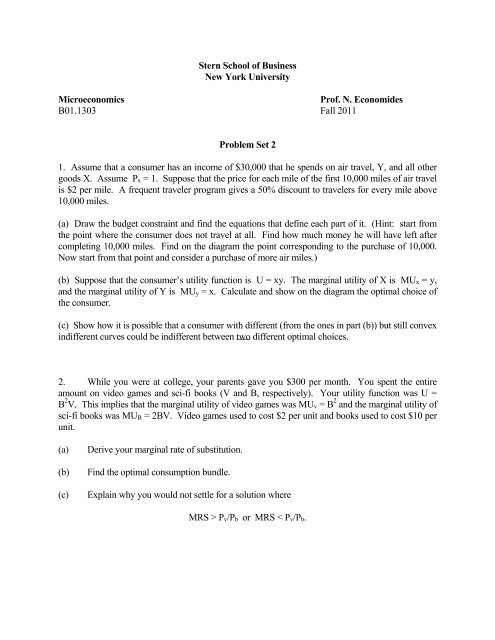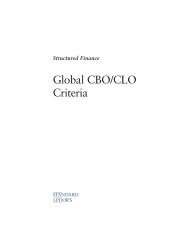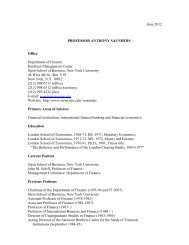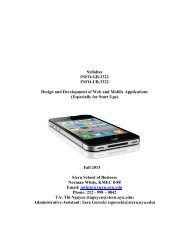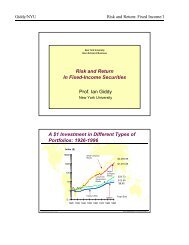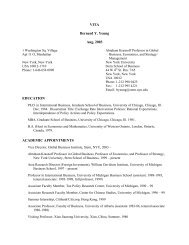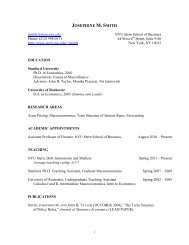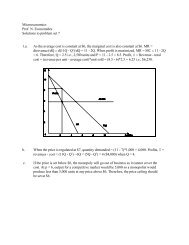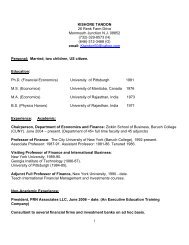Problem Set 2 - NYU Stern School of Business - New York University
Problem Set 2 - NYU Stern School of Business - New York University
Problem Set 2 - NYU Stern School of Business - New York University
Create successful ePaper yourself
Turn your PDF publications into a flip-book with our unique Google optimized e-Paper software.
<strong>Stern</strong> <strong>School</strong> <strong>of</strong> <strong>Business</strong><br />
<strong>New</strong> <strong>York</strong> <strong>University</strong><br />
Microeconomics<br />
Pr<strong>of</strong>. N. Economides<br />
B01.1303 Fall 2011<br />
<strong>Problem</strong> <strong>Set</strong> 2<br />
1. Assume that a consumer has an income <strong>of</strong> $30,000 that he spends on air travel, Y, and all other<br />
goods X. Assume P x = 1. Suppose that the price for each mile <strong>of</strong> the first 10,000 miles <strong>of</strong> air travel<br />
is $2 per mile. A frequent traveler program gives a 50% discount to travelers for every mile above<br />
10,000 miles.<br />
(a) Draw the budget constraint and find the equations that define each part <strong>of</strong> it. (Hint: start from<br />
the point where the consumer does not travel at all. Find how much money he will have left after<br />
completing 10,000 miles. Find on the diagram the point corresponding to the purchase <strong>of</strong> 10,000.<br />
Now start from that point and consider a purchase <strong>of</strong> more air miles.)<br />
(b) Suppose that the consumer’s utility function is U = xy. The marginal utility <strong>of</strong> X is MU x = y,<br />
and the marginal utility <strong>of</strong> Y is MU y = x. Calculate and show on the diagram the optimal choice <strong>of</strong><br />
the consumer.<br />
(c) Show how it is possible that a consumer with different (from the ones in part (b)) but still convex<br />
indifferent curves could be indifferent between two different optimal choices.<br />
2. While you were at college, your parents gave you $300 per month. You spent the entire<br />
amount on video games and sci-fi books (V and B, respectively). Your utility function was U =<br />
B 2 V. This implies that the marginal utility <strong>of</strong> video games was MU v = B 2 and the marginal utility <strong>of</strong><br />
sci-fi books was MU B = 2BV. Video games used to cost $2 per unit and books used to cost $10 per<br />
unit.<br />
(a)<br />
(b)<br />
(c)<br />
Derive your marginal rate <strong>of</strong> substitution.<br />
Find the optimal consumption bundle.<br />
Explain why you would not settle for a solution where<br />
MRS > P v /P b or MRS < P v /P b .
3. The utility that Jane receives by consuming food F and clothing C is given by u(F,C) = FC.<br />
a. Draw the indifference curve associated with a utility level <strong>of</strong> 12 and the indifference<br />
curve associated with the utility level with <strong>of</strong> 24. Are the indifference curves<br />
convex?<br />
b. Suppose that food costs $1 per unit and clothing $3 per unit. Jane has $12 to spend<br />
on food and clothing. Graph the budget line that she faces.<br />
c. What is the utility-maximizing choice <strong>of</strong> food and clothing (solve the problem both<br />
mathematically and graphically).<br />
d. What is the marginal rate <strong>of</strong> substitution <strong>of</strong> food for clothing when utility is<br />
maximized?<br />
e. Suppose Jane buys 3 units <strong>of</strong> food and 3 units <strong>of</strong> clothing with her $12 budget.<br />
Would her marginal rate <strong>of</strong> substitution <strong>of</strong> food for clothing be greater than or less<br />
than 1/3. Explain.


